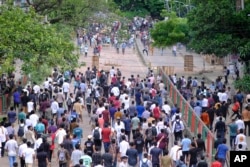Student Union
Vehicles, Guns Are Leading Causes of Death for US Youth

Motor vehicles and firearms kill young Americans more than any other cause, like disease, which has significantly declined, according to a new study.
The New England Journal of Medicine reports that less than 2 percent (or 20,360) of all U.S. deaths — including adults — occur among children and adolescents 1 to 19 years old.
"By 2016," the year for which the most recent data are available, "death among children and adolescents had become a rare event," study authors Dr. Rebecca M. Cunningham, Maureen A. Walton and Dr. Patrick M. Carter of the University of Michigan in Ann Arbor wrote in the Dec. 20 edition.
But in the second largest cause of death among young people — death by firearms — the U.S. leads the world.
"The rate of firearm deaths among children and adolescents was higher in the United States than in all other high-income countries and low-to-middle-income countries with available 2016 data," the authors wrote, or 36.5 times as high as 12 other "high-income" countries.
Data for 2017, which are not included in the NEJM article, show a continued increase in firearm deaths for children and adolescents, Cunningham said.
"One in three U.S. homes with youth under 18 years of age has a firearm, with 43 percent of homes reporting that the firearm is kept unlocked and loaded, which increases the risk of firearm injuries," the authors reported. "In addition to differences in availability between the United States and other countries, there is wide variability across countries in laws relating to the purchase of firearms, access to them and safe storage."
At the same time, "early diagnosis, vaccinations, antibiotics, and medical and surgical treatment" resulted in "declines in deaths from infectious disease or cancer," the report said.
And while motor vehicle events were the leading cause of death for young people, that cause has declined 38 percent over the past decade, the authors wrote.
What caused the declines?
"Seat belts and appropriate child safety seats, the production of cars with improved safety standards, better constructed roads, graduated driver licensing programs, and a focus on reducing teen drinking and driving," the authors wrote, noting that the decline occurred at the same time as increases in the number of U.S. vehicles and annual vehicle-miles traveled.
But there's a hitch: Between 2013 and 2016, research showed the decline leveling. And while researchers said they didn't know for certain, they suspected that distracted driving by teenagers, by other teens in a car or by cellphone use, explained the leveling. The report also wondered about marijuana use and drugged driving leading to "decreased risk perceptions among adolescents."
Among firearm deaths, 59 percent were homicides, 35 percent were suicides, and 4 percent were unintentional injuries such as accidental discharges of firearms, which aligns with incidents among Americans older than 20.
Death by firearms
Among the unintentional firearm deaths — less than 2 percent of all U.S. firearm deaths — 26 percent occurred among children and adolescents, the report said.
"Malignant neoplasms," like cancer, were the third-leading cause of death, representing 9 percent of deaths among children and adolescents. That was followed by suffocation (7 percent) because of "bed linens, plastic bags, obstruction of the airway, hanging or strangulation."
Among the youngest children, 1 to 4 years-old, drowning in swimming pools, rivers and lakes was the most common cause of death, the report said. Death by drowning was more rare in older children, "which potentially reflects widespread swim training among school-aged children."
Among youth 10 to 19 years of age, injury deaths from motor vehicle crashes, firearms and suffocation were the three leading causes. Researchers said these causes reflected "increased risk-taking behavior, differential peer and parental influence, and initiation of substance use."
Drug overdoses or poisonings rose to the sixth-leading cause of death among children and adolescents in 2016, the report said, attributed to an increase in "opioid overdoses, which account for well over half of all drug overdoses among adolescents."
Mortality was higher among blacks (38.2 per 100,000) and American Indians or Alaska Natives (28.0 per 100,000) than among whites (24.2 per 100,000) and Asians or Pacific Islanders (15.9 per 100,000), the authors wrote. Deaths related to firearms were the leading cause of death among black youth and occurred 3.7 times the rate of such deaths among white youth.
Drowning deaths
Black youth also had higher rates of drowning deaths (1.6 times as high) and fire-related deaths (2.3 times as high) than white youth. Blacks had death rates from heart disease and chronic lower respiratory diseases such as asthma that were 2.1 and 6.3 times as high, respectively, as the rates among white youth.
"Such disparities probably reflect underlying socioeconomic issues, including poverty, environmental exposures and differential access to health care services," the researchers wrote.
"Progress toward further reducing deaths among children and adolescents will require a shift in public perceptions so that injury deaths are viewed not as 'accidents,' but rather as social ecologic phenomena that are amenable to prevention." the authors concluded.
Researchers compiled their report on data from the Wide-ranging Online Data for Epidemiologic Research (WONDER) system of the Centers for Disease Control and Prevention (CDC) from 57 vital-statistics jurisdictions.
See all News Updates of the Day
Tips for first-year international students in the US
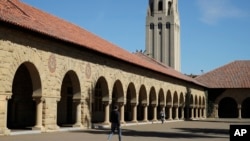
Book your flights right away, get a U.S. phone plan, make sure you have linens for your dorm and attend orientation – that’s some of the advice international students have for first-year college students coming from abroad.
U.S. News & World Report compiled helpful tips for students studying in the United States for the first time. (July 2024)
Survey: Social integration, career prep are important to international students
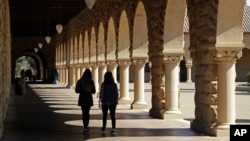
A recent survey of international students in the United States found that before starting school, they were concerned about personal safety, making friends and feeling homesick.
Inside Higher Ed reports that international students want specialized orientations, peer connections, career preparation and job placement to help make their college experiences successful. (July 2024)
US advisory council ends Nigeria visit, signs student exchange deal

Members of a U.S. presidential advisory council have approved a student exchange deal between an American college and a Nigerian university as part of the council's effort to strengthen collaboration on education, health, entrepreneurship and development between Africa and Africans living abroad.
The council also visited a health facility supported by the United States Agency for International Development in the capital.
Nigerian authorities and visitors chatted with members of the U.S President's Advisory Council on African Diaspora Engagement as they toured a healthcare facility in Karu, a suburb of Abuja, on the last day of the council's three-day visit to Abuja and Lagos.
The facility is one of many supported by the United States Agency for International Development, or USAID, to improve the management of childhood illnesses, family planning, immunization and delivery.
The tour was part of the council's effort to promote African diaspora-led investments in technology entrepreneurship, education and healthcare delivery.
"They're doing a phenomenal job there, it really gave us a sense of what the healthcare system is in Nigeria," said Deniece Laurent-Mantey, executive director of the advisory council. "This is our first trip as a council to the continent and we chose Nigeria for a reason — the diaspora in Nigeria is very active, very influential, and they're really a source of strength when it comes to our U.S.-Africa policy. And so for us coming to Nigeria was very intentional."
The council was created by President Joe Biden in September to improve collaboration between Africa and its diaspora in terms of economic and social development.
Akila Udoji, manager of the Primary Healthcare Centre of Karu, said officials in Nigeria were pleased that the council members were able to visit.
"We're happy that they have seen what the money they have given to us to work with has been used to do, because they have been able to assist us in capacity-building, trainings, equipment supply and the makeover of the facility," Udoji said.
Earlier, the council signed a deal for a student exchange program between Spelman College in the southern U.S. city of Atlanta and Nigeria's University of Lagos.
Laurent-Mantey said education exchanges are one of the council's top priorities.
"In Lagos, we had the president of Spelman College — she's also a member of our council — she signed an agreement with the University of Lagos to further education exchange programs in STEM and creative industries between those two universities," Laurent-Mantey said. "And I think for us it's very important, because Spelman College is a historically Black university, and so here we are promoting the importance of collaboration between African Americans and Africans."
In March, the advisory council adopted its first set of recommendations for the U.S. president, including the student exchange initiative, advocating for more U.S. government support for Africa, climate-focused initiatives, and improving U.S. visa access for Africans.
The council met with Nigerian health and foreign affairs officials during the visit before leaving the country on Wednesday.
American Academy of the Arts College announces closure
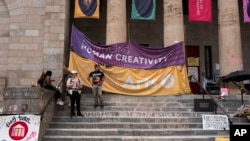
The American Academy of Art College in Chicago announced it would be closing after 101 years of preparing students for careers in art and illustration.
WTTW news reported that like other art colleges, the academy saw enrollment drop after the pandemic, and officials made the decision to close the college last month. (July 2024)
5 killed, dozens injured in clashes over Bangladesh jobs quota system
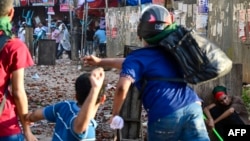
At least 5 people were killed and dozens injured in two separate incidents in Bangladesh as violence continued Tuesday on university campuses in the nation's capital and elsewhere over a government jobs quota system, local media reports said quoting officials.
At least three of the dead were students and one was a pedestrian, the media reports said. Another man who died in Dhaka remained unidentified.
The deaths were reported Tuesday after overnight violence at a public university near Bangladesh's capital, Dhaka. The violence involved members of a pro-government student body and other students, when police fired tear gas and charged the protesters with batons during the clashes, which spread at Jahangir Nagar University in Savar, outside Dhaka, according to students and authorities.
Protesters have been demanding an end to a quota reserved for family members of veterans who fought in Bangladesh's war of independence in 1971, which allows them to take up 30% of governmental jobs.
They argue that quota appointments are discriminatory and should be merit-based. Some said the current system benefits groups supporting Prime Minister Sheikh Hasina. Some Cabinet ministers criticized the protesters, saying they played on students' emotions.
The Bengali-language Prothom Alo daily newspaper reported that one person died in Dhaka and three others, including a pedestrian, were killed after they suffered injuries during violence in Chattogram, a southeastern district, on Tuesday.
Prothom Alo and other media reports also said that a 22-year-old protester died in the northern district of Rangpur.
Details of the casualties could not be confirmed immediately.
While job opportunities have expanded in Bangladesh's private sector, many find government jobs stable and lucrative. Each year, some 3,000 such jobs open up to nearly 400,000 graduates.
Hasina said Tuesday that war veterans — commonly known as "freedom fighters" — should receive the highest respect for their sacrifice in 1971 regardless of their current political ideologies.
"Abandoning the dream of their own life, leaving behind their families, parents and everything, they joined the war with whatever they had," she said during an event at her office in Dhaka.
Protesters gathered in front of the university's official residence of the vice chancellor early Tuesday when violence broke out. Demonstrators accused the Bangladesh Chhatra League, a student wing of Hasina's ruling Awami League party, of attacking their "peaceful protests." According to local media reports, police and the ruling party-backed student wing attacked the protesters.
But Abdullahil Kafi, a senior police official, told the country's leading English-language newspaper Daily Star that they fired tear gas and "blank rounds" as protesters attacked the police. He said up to 15 police officers were injured.
More than 50 people were treated at Enam Medical College Hospital near Jahangir Nagar University as the violence continued for hours, said Ali Bin Solaiman, a medical officer of the hospital. He said at least 30 of them suffered pellet wounds.
On Monday, violence also spread at Dhaka University, the country's leading public university, as clashes gripped the campus in the capital. More than 100 students were injured in the clashes, police said.
On Tuesday, protesters blocked railways and some highways across the country, and in Dhaka, they halted traffic in many areas as they vowed to continue demonstrating until the demands were met.
Local media said police forces were spread across the capital to safeguard the peace.
Swapon, a protester and student at Dhaka University who gave only his first name, said they want the "rational reformation of the quota scheme." He said that after studying for six years, if he can't find a job, "it will cause me and my family to suffer."
Protesters say they are apolitical, but leaders of the ruling parties accused the opposition of using the demonstrations for political gains.
A ruling party-backed student activist, who refused to give his name, told The Associated Press that the protesters with the help of "goons" of the opposition's Bangladesh Nationalist Party and Jamaat-e-Islami party vandalized their rooms at the student dormitories near the Curzon Hall of Dhaka University.
The family-of-the-veterans quota system was halted following a court order after mass student protests in 2018. But last month, Bangladesh's High Court nulled the decision to reinstate the system once more, angering scores of students and triggering protests.
Last week, the Supreme Court suspended the High Court's order for four weeks and the chief justice asked protesting students to return to their classes, saying the court would issue a decision in four weeks.
However, the protests have continued daily, halting traffic in Dhaka.
The quota system also reserves government jobs for women, disabled people and ethnic minority groups, but students have protested against only the veterans system.
Hasina maintained power in an election in January that was again boycotted by the country's main opposition party and its allies due to Hasina's refusal to step down and hand over power to a caretaker government to oversee the election.
Her party favors keeping the quota for the families of the 1971 war heroes after her Awami League party, under the leadership of her father, Sheikh Mujibur Rahman, led the independence war with the help of India. Rahman was assassinated along with most of his family members in a military coup in 1975.




